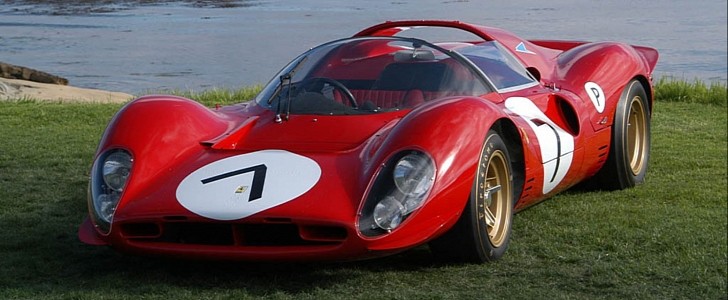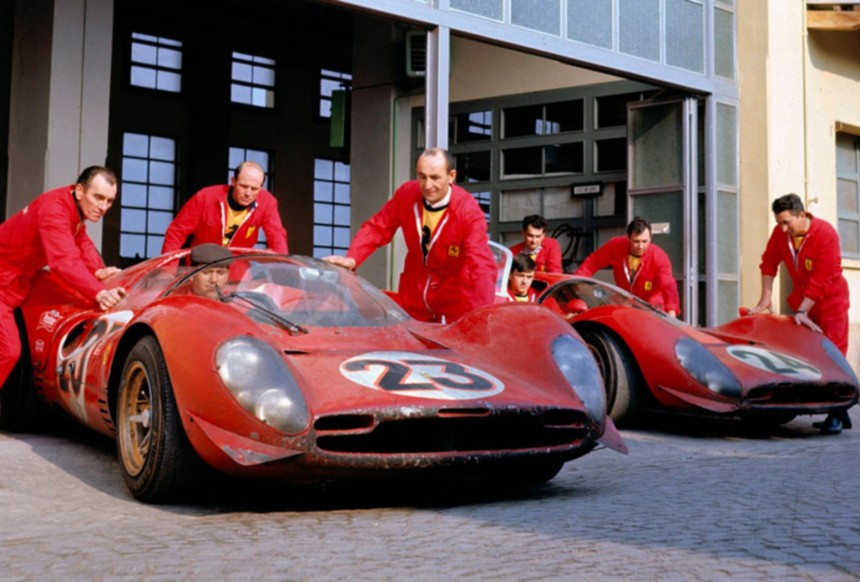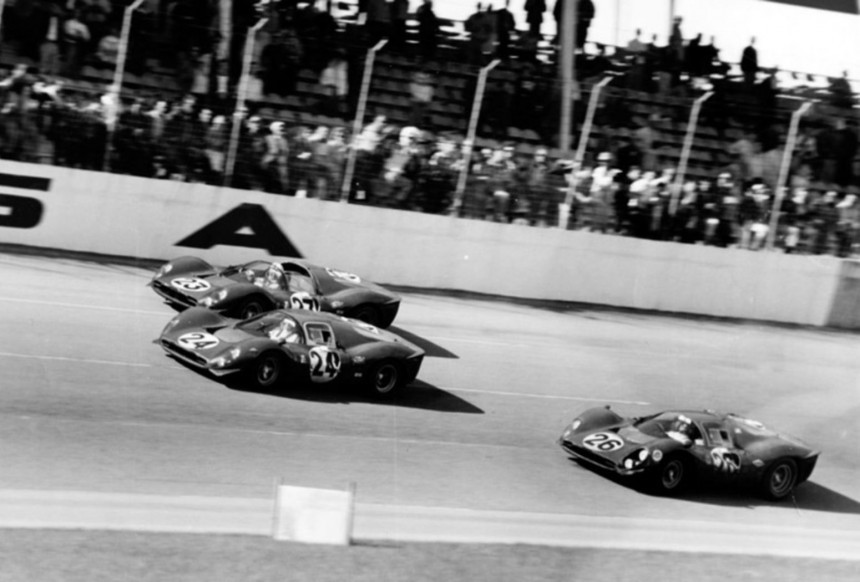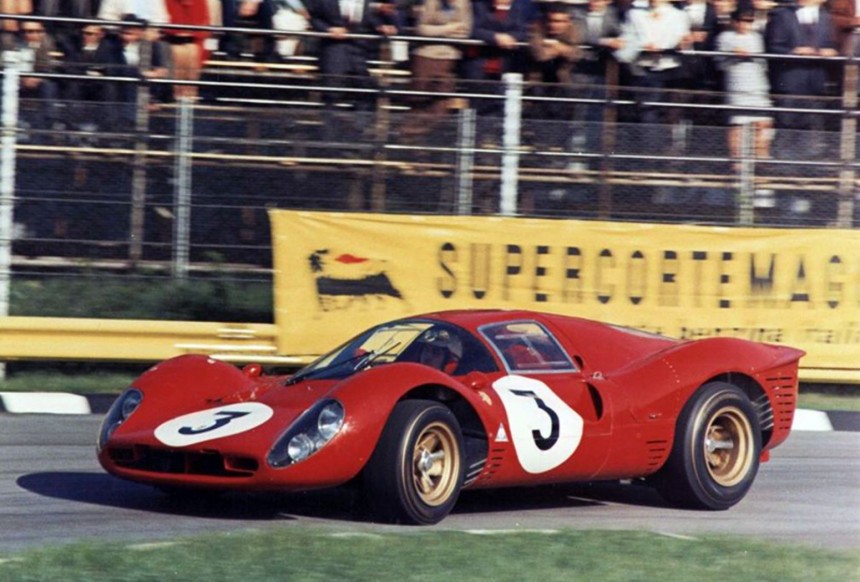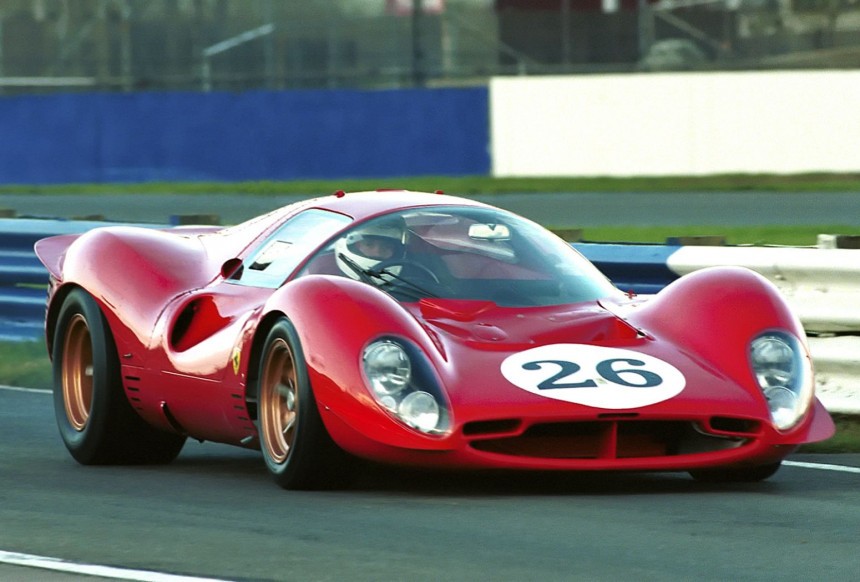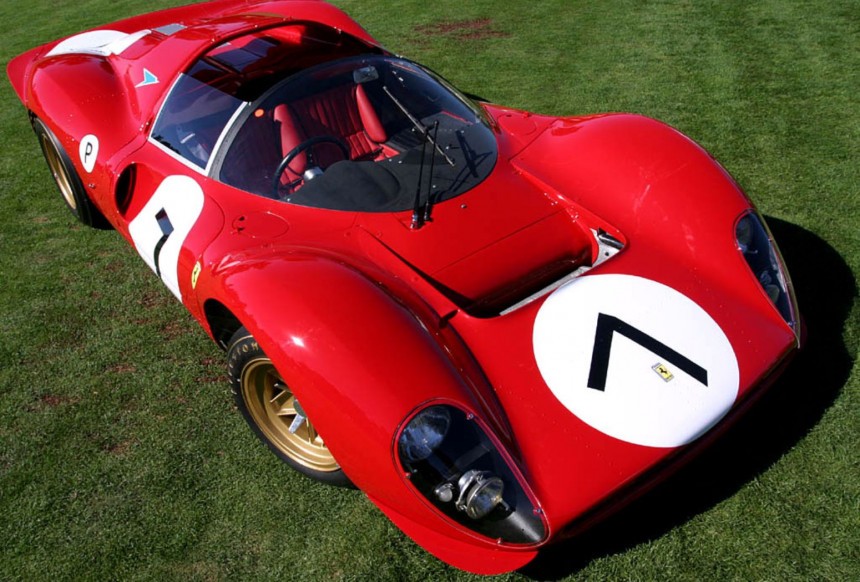Built at the height of the epic Ford vs. Ferrari war for endurance racing supremacy, the 330 P4 didn’t manage to outshine the GT40 Mk IVs at Le Mans. However, three of them secured a 1-2-3 finish at Daytona and went on to help the Prancing Horse win the manufacturers’ title in the World Sportscar Championship (WSC) that season.
As the Italian manufacturer was racking up victories in endurance racing and Formula One during the late ‘50s and early ‘60s, they were becoming the most popular name in the automotive world. On the other side of the Atlantic, the Blue Oval wanted to boost its image and decided that buying out Ferrari would be the ultimate marketing stunt. In 1963, a delegation went to Maranello to try and persuade Enzo to sell the controlling stake but after nearly a month of negotiations, everything fell apart, as the boss used Ford’s offer to get a better deal from Fiat.
This enraged Henry Ford II who decided to start a new racing program meant to end Ferrari’s domination in the world of endurance racing. With the help of Carroll Shelby and his team, Ford managed to build an excellent car that successfully annihilated the Italian cars in 1966 and the epic Ford vs. Ferrari rivalry was now in full swing.
Since the 330 P3 had failed miserably due to engine overheating and gearbox problems, it needed to be fundamentally redesigned. The unreliable Tipo 593 ZF transmission was thrown into the trash bin and replaced with a new in-house developed five-speed unit that would be mated to a radically improved engine.
With Enzo and chief engineer Mauro Forghieri breathing down his neck, Franco Rocchi was the man in charge of overhauling the powerplant. It became the first Ferrari engine to employ three valves per cylinder and got a pair of new heads derived from an F1 unit. Additionally, the Lucas fuel injection system which debuted on the P3 and sat between the cylinder banks was now moved between the camshafts to improve efficiency. With these upgrades, the long-block V12 was now capable of generating around 450 hp (335 kW) but more importantly, it was deemed much more reliable.
While the bodywork was nearly identical to that of the P3, the tubular steel chassis saw several improvements which lead to a shorter wheelbase with a wider track. Three new cars were built, all as closed-top Beriinettas whereas one P3 was partially converted to P4 specs becoming known as the P3/4 or P4 Spyder because it lacked a roof.
With the addition of ex-Ford driver and Le Mans winner Chris Amon, the 1967 season kicked off with a bang on American soil. After 560 test laps at Daytona a few months before the 24-hour race, the P4 was ready for its official debut.
From start to finish, the fleet of Ferraris dominated and three of them eventually crossed the line simultaneously, replicating Ford’s iconic Le Mans photo from the previous year. This new photo became known as ‘The Revenge of Il Commendatore’ and legend has it that Enzo kept it by his side until he died.
The Americans won the second race at Sebring two months later, after which Ferrari came back on top in Italy, at Monza. Neither manufacturer triumphed in the three events that followed but both were heavily concentrated on the 24-hour race in France.
Held on the Circuit de la Sarthe, the 35th iteration of the legendary race was shaping up to be one for the history books.
Ferrari came with the P4 Spyder that finished 1st at Daytona and two P4s as the works cars. Additionally, the last remaining P4 and three 412P were lent to privateers Jacques Swaters and Johnny Claes’ Equipe Nationale Belge (Belgian National Team).
During the practice weekend in April, Bandini was fastest in the Ferrari P4 Spyder with a spectacular lap record of 3:25.4. However, things didn’t go as planned in the qualifying sessions two months later. Ford came with aerodynamically improved GT40 Mk IVs that were dangerously unstable at high speeds but significantly faster than any other car.
Pole position went to Bruce McLaren and his Mk IV with a 3:24.4 time, followed by Phil Hill’s Chaparral, and four other GT40s. The fastest Ferrari which was driven by Mike Parkes at the time only managed to secure seventh place on the grid while the other works P4 of Günter Klass did not finish the session after crashing into the trees.
Although Ferrari engineers managed to repair the damaged car and hoped their luck will turn on race day, the team was already in big trouble after only two hours. Foyt, Hill, and Andretti’s Fords were in the lead and already had a lap on their rivals and the rest of the pack.
As the night fell, the Chris Amon’s P4 Spyder suffered a puncture. Because of a faulty mallet, it couldn’t be fixed on the side of the track, so the Aussie had to creep back to the pits, losing the 5th position. Unfortunately, sparks from the wheel hub ignited a fire in the engine bay so Amon had to bail out as the car burned to a wreck.
The two remaining P4s soldiered on and next morning were lapping the track 10 seconds faster than the leading Ford of Dan Gurney and A. J. Foyt. However, the Americans had such a huge lead that they couldn’t be caught. Eventually, their no.1 GT40 crossed the finish line first, with five laps over the Ferraris which completed the race in second and third.
Enzo had to grudgingly admit that his cars were just not good enough, yet all was not lost for the Scuderia and the 330 P4.
The team did not win any of the races left on the calendar but kept racking up points. By the end of the season, Ferrari had secured the WSC manufacturers' title, with Ford finishing third.
For the 10th contest held in England on the Brands Hatch circuit, the three P4s were converted to Spyders and received minor aero modifications. Two of them were subsequently converted into Can-Am racers whereas chassis number 0856 was spared and survives to this day. It changed owners throughout the years and is now one of the most expensive historic race cars in the world. It was purchased by Canadian billionaire and Aston Martin shareholder Lawrence Stroll in 2000 for around $9 million and was reportedly sold again last year but no details about this deal have been made public.
Although the 1967 Ferrari 330 P4 didn’t manage to outduel the Ford GT40 Mk IV at Le Mans and has been portrayed as a losing car in recent years, it’s considered by many enthusiasts and experts as the best endurance machine ever built in Maranello. It helped the carmaker secure a manufacturer’s championship in the premier class of the WSC and made Enzo proud at Daytona where it obliterated its rivals.
This enraged Henry Ford II who decided to start a new racing program meant to end Ferrari’s domination in the world of endurance racing. With the help of Carroll Shelby and his team, Ford managed to build an excellent car that successfully annihilated the Italian cars in 1966 and the epic Ford vs. Ferrari rivalry was now in full swing.
The Birth of the 330 P4
With Enzo and chief engineer Mauro Forghieri breathing down his neck, Franco Rocchi was the man in charge of overhauling the powerplant. It became the first Ferrari engine to employ three valves per cylinder and got a pair of new heads derived from an F1 unit. Additionally, the Lucas fuel injection system which debuted on the P3 and sat between the cylinder banks was now moved between the camshafts to improve efficiency. With these upgrades, the long-block V12 was now capable of generating around 450 hp (335 kW) but more importantly, it was deemed much more reliable.
While the bodywork was nearly identical to that of the P3, the tubular steel chassis saw several improvements which lead to a shorter wheelbase with a wider track. Three new cars were built, all as closed-top Beriinettas whereas one P3 was partially converted to P4 specs becoming known as the P3/4 or P4 Spyder because it lacked a roof.
Sweet Revenge
From start to finish, the fleet of Ferraris dominated and three of them eventually crossed the line simultaneously, replicating Ford’s iconic Le Mans photo from the previous year. This new photo became known as ‘The Revenge of Il Commendatore’ and legend has it that Enzo kept it by his side until he died.
The Americans won the second race at Sebring two months later, after which Ferrari came back on top in Italy, at Monza. Neither manufacturer triumphed in the three events that followed but both were heavily concentrated on the 24-hour race in France.
The 1967 Le Mans Race
Ferrari came with the P4 Spyder that finished 1st at Daytona and two P4s as the works cars. Additionally, the last remaining P4 and three 412P were lent to privateers Jacques Swaters and Johnny Claes’ Equipe Nationale Belge (Belgian National Team).
During the practice weekend in April, Bandini was fastest in the Ferrari P4 Spyder with a spectacular lap record of 3:25.4. However, things didn’t go as planned in the qualifying sessions two months later. Ford came with aerodynamically improved GT40 Mk IVs that were dangerously unstable at high speeds but significantly faster than any other car.
Pole position went to Bruce McLaren and his Mk IV with a 3:24.4 time, followed by Phil Hill’s Chaparral, and four other GT40s. The fastest Ferrari which was driven by Mike Parkes at the time only managed to secure seventh place on the grid while the other works P4 of Günter Klass did not finish the session after crashing into the trees.
Although Ferrari engineers managed to repair the damaged car and hoped their luck will turn on race day, the team was already in big trouble after only two hours. Foyt, Hill, and Andretti’s Fords were in the lead and already had a lap on their rivals and the rest of the pack.
The two remaining P4s soldiered on and next morning were lapping the track 10 seconds faster than the leading Ford of Dan Gurney and A. J. Foyt. However, the Americans had such a huge lead that they couldn’t be caught. Eventually, their no.1 GT40 crossed the finish line first, with five laps over the Ferraris which completed the race in second and third.
Enzo had to grudgingly admit that his cars were just not good enough, yet all was not lost for the Scuderia and the 330 P4.
After Le Mans
For the 10th contest held in England on the Brands Hatch circuit, the three P4s were converted to Spyders and received minor aero modifications. Two of them were subsequently converted into Can-Am racers whereas chassis number 0856 was spared and survives to this day. It changed owners throughout the years and is now one of the most expensive historic race cars in the world. It was purchased by Canadian billionaire and Aston Martin shareholder Lawrence Stroll in 2000 for around $9 million and was reportedly sold again last year but no details about this deal have been made public.
Although the 1967 Ferrari 330 P4 didn’t manage to outduel the Ford GT40 Mk IV at Le Mans and has been portrayed as a losing car in recent years, it’s considered by many enthusiasts and experts as the best endurance machine ever built in Maranello. It helped the carmaker secure a manufacturer’s championship in the premier class of the WSC and made Enzo proud at Daytona where it obliterated its rivals.
